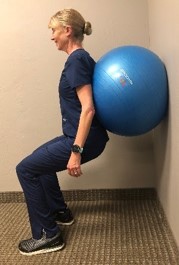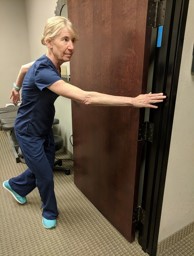
Chiropractor Chandler AZ
Prehabilitation for Knee Replacement Surgery in Chandler
If you are anticipating a knee replacement surgery in the near future, you can optimize your chances for recovery with prehabilitation. Prehabilitation is “improving the functional capacity of an individual through physical activity to withstand a stressful event.” (Ditmyer et al, 2002). Prior to knee surgery, many individuals experience increased pain, decreased muscle strength and range of motion that make it more difficult to perform daily tasks and engage in recreation. Being sedentary prior to the surgery compounds the challenges of rehabilitating the knee joint afterwards. An exercise program prior to the procedure consisting of mild resistance training, step training, walking and easy stretching will enable you to progress back to full function more effectively after surgery.
What is Knee Replacement Surgery Prehabilitation
Prehabilitation for knee replacement should start about eight weeks prior to the procedure. It begins with assessing your baseline:
- What factors are contributing to range of motion limitations in the knee: has scar tissue built up in and around the tendons and ligaments? Is there significant swelling, and what is causing it?
- What muscle strength deficits exist, particularly in the quadriceps that are the “prime movers” for walking and running, and that control knee motion going up and down stairs?
- Do muscle imbalances exist between the medial and lateral quadriceps muscles?
- What other factors are contributing to declines in function, including foot structure, lack of lateral hip strength, etc.?
You will notice that none of these issues are directly related to osteoarthritis, yet each has been impacted by the pain and movement limitations osteoarthritis has caused. While TKA (total knee arthroplasty) will repair osteoarthritic damage to the knee, it will not fix the muscle imbalances, strength deficits or functional issues in other parts of the “kinetic chain” affecting your ability to move easily and pain-free.
It is likely that you will be revisiting each of the areas listed above as you rehabilitate after surgery. Prehabilitation minimizes loss of function so that you can start your rehab from a higher baseline than if you were inactive leading up to the procedure.
Video: Conservative Treatment Before Surgery
Symptoms of Osteoarthritis in the Knee
There are various causes for knee pain, including injury to the ligaments and menisci inside the knee and patellar tracking problems. While these can be caused by acute injury, osteoarthritis is a chronic condition that progresses slowly over time.
Symptoms can include:
- Stiffness first thing in the morning that lasts less than 30 minutes.
- Crepitus (crackling sound)
- Bony enlargement and tenderness
- Pain that gets worse as the day progresses and is relieved with rest.
- Laxity or instability of the joint.
- Limited range of motion that gets worse as the condition progresses.
Who is at Risk for Knee Replacement Surgery?
Although the majority of knee replacement procedures are on older adults, younger individuals, especially those who have experienced sports-related knee injuries, often need the procedure as well. Risk for total knee replacement increases with the following factors:
- Former knee injuries, particularly traumatic injuries from sports such as basketball, football, rugby and soccer.
- Poor biomechanics that has contributed to chronic injuries such as runner’s knee (patellar tendonitis and tendonosis).
- Advanced osteoarthritis, “wear and tear” arthritis that has led to degeneration of cartilage inside the knee and the development of bone spurs in the area.
- Overweight or obesity (more stress on the knee joint).
- Smoking.
- Lack of physical activity.
- Other chronic conditions including diabetes and cancer survivorship that may have caused nerve damage or circulatory issues.
- Osteopenia or osteoporosis.
Prehabilitation at Home
Your physician may recommend the use of over-the-counter anti-inflammatory medications to minimize the pain and swelling prior to surgery. Be sure to follow dosing instructions, since all medications can have side effects that are exacerbated when they are overused.
If you have inflammation in and around the knee, ice is your best friend. We like the large gel packs because they are easy to mold around the knee and are reusable. Ice several times per day. Compression stockings and elevating the leg, particularly after standing for extended periods of time, can also relieve the swelling.
You may find it useful to wear a brace available at most pharmacies to give the knee some extra support. One caveat is that these braces limit joint motion, so be careful about compensating: (this can lead to pain in the opposite knee).
Walk as much as you can, even if the length of each walk is very short. Several five-to-ten minute walks every day will have a big impact on maintaining muscle strength.


Active Treatments
Although the above treatments are helpful, you will find a great deal of benefit in pursuing a structured prehabilitation program with a physical therapist. The physical therapist can perform a baseline assessment to determine where strength deficits and muscle imbalances exist, identify any other contributing factors such as overpronation, internal tibial rotation and lateral hip instability. He or she can then design a prehabilitation program to address these problems prior to surgery.
To assess the difference prehabilitation prior to knee replacement makes on function leading up to surgery and during rehabilitation, a research team from the International Council on Active Aging conducted a study on 54 patients scheduled for TKA. Half were assigned to prehabilitation and half to usual care.
According to researchers:
“Between baseline and just prior to surgery, participants in the prehabilitation exercise group significantly increased their ability to complete sit-to-stand repetitions in 30 seconds and increased the distance they covered during the 6-minute walk… These findings demonstrate the effectiveness of the prehabilitation protocol to improve performance of functional tasks prior to TKA surgery.” (Topp et al., 2009).
Alternative Treatments
An eight-week prehabilitation program for TKA might consist of the following:
- Lower body resistance training using TheraBands. These include hip abduction and adduction, leg lifts (front and rear) and walking drills.
- Step training: step-ups and step downs to make it easier to navigate steps prior to surgery. One thing many individuals don’t realize is how much lack of control on steps impacts their fall risk. Consider a common scenario: stepping off a curb with arms full of groceries in a parking lot. If you are unable to negotiate the curb, you significantly increase the risk of losing your balance and falling.
- Sit-to-stand exercises, to make it easier to get in and out of chairs (and cars), and once again, decrease fall risk.
- Static stretching of the gluteal, hip, hamstring, calf, and lower back muscles. Light stretching of the quadriceps muscles (within comfortable range of motion) is also helpful.
It is not uncommon for scar tissue to build up around the knee joint after years of living with osteoarthritis. You might not even realize how much the scar tissue (and fascial adhesions) are limiting your movement. The knee replacement procedure will not address this problem, and the scar tissue will impact your ability to rehab after surgery. A very successful procedure for breaking up this scar tissue and fascial adhesions in the surrounding musculature is the Graston Technique.

Graston Technique for Knee Pain & Osteoarthritis
Graston technique can be used on the leg muscles, tendons and ligaments in and around the knee to improve mobility for patients with knee osteoarthritis. Graston technique uses stainless steel instruments designed to break up scar tissue by sheer force. When the tools slide along the skin they help pull one layer of tissue past the other. The scar tissue that has developed from micro-tears in the ligaments, tendons and muscles is pulled apart, triggering the body’s healing mechanisms to repair the fibers. Scar tissue in and around the knee area can build up after years of poor biomechanics related to osteoarthritis. Treatment with Graston technique increases mobility in the area and slows down disease progression. Read more knee pain and Graston Technique.
Cold Laser Therapy for Knee Osteoarthritis in Chandler
Class IV cold laser or low level laser therapy is an excellent treatment modality for decreasing pain and inflammation. Specific wavelengths and frequencies shut off the inflammatory cells that accompany osteoarthritis. Excessive inflammation reduces range of motion and can make moving painful. Different laser wavelengths and frequencies help to turn on the healing processes inside cells. They speed up the delivery of adenosine triphosphate (ATP), which is ‘fuel’ for the body produced from the blood sugar your body creates from food. As a result, repairing cells can lay down healthy fibers faster, speeding up healing and repair processes. Learn more on class IV laser for knee pain.

Shockwave Therapy
Extracorporeal shockwave therapy utilizes a percussive instrument to break fascial adhesions around the knee. It is very effective for reducing tightness in IT bands on the lateral side of the knee that may develop due to weakness in the VMOs (vastus medialis oblique muscles, i.e. the section of the innermost quadricep just above the knee). Shockwave is also effective for relieving tension in and around the patellar tendon and in the lower leg.
Video: Shockwave Therapy For Tendon & Ligament Injuries
Lower Body Exercises:
Lower body exercises to improve leg strength, flexibility, foot dorsiflexion and lateral hip strength can make a significant difference in your ability to function prior to surgery. Because these exercises address many of the issues behind the progression of your osteoarthritis, they may decrease pain in the knee as well.
Balance exercises will help you to move more comfortably by addressing any gait abnormalities you may have developed by compensating with the other leg. In addition to helping you to move more comfortably, they will also reduce your fall risk.
Exercises to strengthen the quadriceps muscles can include step-ups and step-downs, leg lifts, ball squeeze, supine leg extension, walking with an exaggerated gait and progressive resistance band exercises. In between sessions with the physical therapist, you can do many of these exercises at home since they require minimal equipment.
Lateral hip stability exercises address weakness in the gluteal muscles (medius and minimus) that stabilize the hips during walking as well as twisting and side-to-side movements. Examples of these exercises include glute bridging and seated exercises on the exercise ball. See our section on Lower Body Exercises for more information.

Medical Treatments
If over-the-counter anti-inflammatory medications fail to address pain and swelling in the knee, your primary care provider or orthopedic surgeon may recommend a corticosteroid injection. This will relieve the pain and may enable you to make better progress on your prehabilitation efforts. Additional injections including PRP for knee pain and or hyaluronic acid injections to increase joint fluid and reduce impact on knee meniscus. Patients respond differently to these treatments but have seen many happy with the procedures.
If you are planning to undergo knee replacement surgery within the next couple of months, now is the time to begin your prehabilitation. It will help you to maintain maximum function and strength leading up to the procedure, and improve your outcome afterwards. Call Alpha Chiropractic and Physical Therapy today to schedule your consultation and begin your prehabilitation at (480) 812-1800.
Our Chandler Chiropractic & Physical Therapy clinic treats patients with a variety of muscle, tendon, joint and ligament injuries. The clinic provides treatment for endurance athletes and weekend warriors in addition to common headache, neck and back patients traditionally seen in Chiropractic, Physical Therapy, Massage Therapy clinics. We work with all ages and abilities of the residents in Ahwatukee, Phoenix, Tempe, Gilbert, Mesa and Chandler AZ.